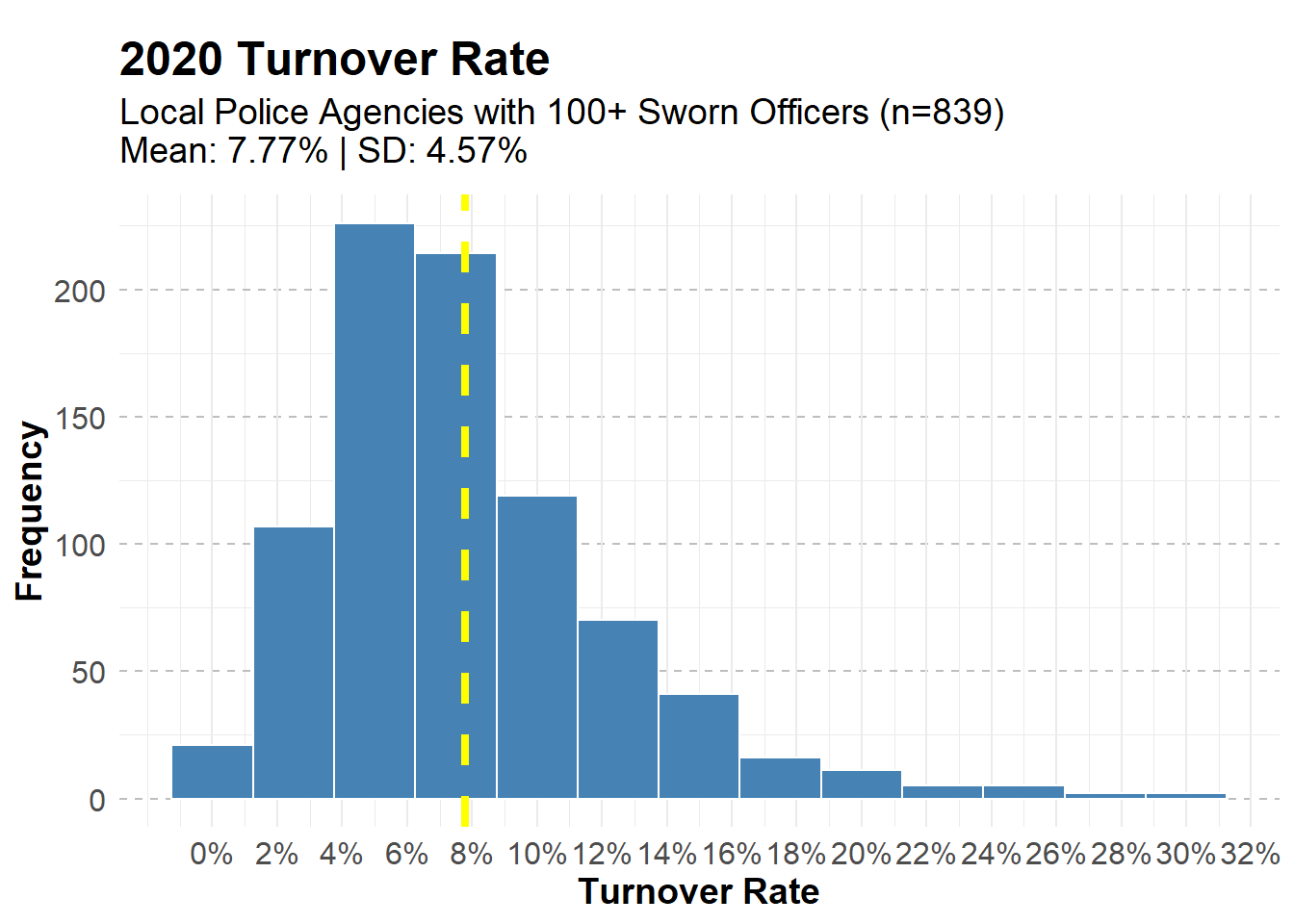LEMAS 2016 and 2020 Turnover Comparison
In this blog post, we will analyze and compare the turnover rates of local police agencies with 100 or more sworn officers in the United States using the Law Enforcement Management and Administrative Statistics (LEMAS) data from 2016 and 2020. By the end of this post, you will learn how to import, preprocess, and visualize the LEMAS data to gain insights into the turnover rates of law enforcement agencies.
Setup
First, let’s load the required libraries and set some global options for our code chunks. We will be using:
library(tidyverse)
library(readr)
library(here)
library(scales)
library(viridis)Next, we will import the 2016 and 2020 LEMAS data and preprocess it, including cleaning column names and selecting relevant columns for our analysis. Make sure you have already imported the 2016 data to an object named df_raw_2016 and the 2020 data to one named df_raw_2020.
Data Import and Preprocessing
In this section, we will import the 2016 and 2020 LEMAS data, preprocess the data, and calculate the turnover rates.
LEMAS 2016 Data
Let’s start by importing the 2016 LEMAS data and preprocessing it.
## Import 2016 data
# Select relevant columns and calculate vacancies
df_2016 <- df_raw_2016 %>% select(
lear_id,
agencyname,
agencytype,
strata,
population = popserved,
ftsauth,
ftsworn,
total_separations = pers_sep_totr
) %>% mutate(vacancies = ftsauth - ftsworn) %>%
filter(vacancies >= 0)
# Calculate vacancy and turnover rates
df_2016 <- df_2016 %>%
mutate(vac_rate = (round((vacancies)/(ftsauth), digits = 2))*100,
turnover_rate = total_separations / ftsworn)
# Filter agencies with 100 or more sworn officers
df100_2016 <- df_2016 %>% filter(strata == "(101) LP: 100+")LEMAS 2020 Data
Now, let’s import and preprocess the 2020 LEMAS data.
# Import 2020 data
# Renaming
df_2020 <- df_raw_2020 %>% select(
agencyid,
agencyname,
agencytype = agencysamptype,
strata,
population = primarypop2020,
sworn2019 = ftsworn_2019,
sworn2020 = ftsworn,
total_separations = tot_sep,
vacancy2019 = ftvac_2019,
vacancy2020 = ftvac
)
# Calculate vacancy rates
df_2020$vac_rate2020 <- (round((df_2020$vacancy2020)/(df_2020$sworn2020 + df_2020$vacancy2020), digits = 2))*100
df_2020$vac_rate2019 <- (round((df_2020$vacancy2019)/(df_2020$sworn2019 + df_2020$vacancy2019), digits = 2))*100
df_2020$turnover_rate <- df_2020$total_separations / df_2020$sworn2020
df100_2020 <- df_2020 %>% filter(sworn2019 > 99)Now that we have imported and preprocessed both the 2016 and 2020 LEMAS datasets, let’s move on to visualizing the turnover rates and comparing them side-by-side.
Turnover Rate Comparison
In this section, we will create a side-by-side comparison of the 2016 and 2020 turnover rates for local police agencies with 100 or more sworn officers.
First, we will filter out the outliers and calculate the mean and standard deviation for the turnover rates in both datasets.
df100_filtered_2016 <- df100_2016 %>%
filter(turnover_rate <= 0.30)
turnover_mean_2016 <- mean(df100_filtered_2016$turnover_rate, na.rm = TRUE)
turnover_sd_2016 <- sd(df100_filtered_2016$turnover_rate, na.rm = TRUE)
df100_filtered_2020 <- df100_2020 %>%
filter(turnover_rate <= 0.30)
turnover_mean_2020 <- mean(df100_filtered_2020$turnover_rate, na.rm = TRUE)
turnover_sd_2020 <- sd(df100_filtered_2020$turnover_rate, na.rm = TRUE)Next, let’s create a reusable function to generate the turnover rate plots for both years.
plot_turnover <- function(df, year, mean, sd) {
ggplot(data = df, aes(x = turnover_rate)) + # Create the base ggplot with turnover_rate on the x-axis
geom_histogram(binwidth = 0.025, fill = "steelblue", color = "white") + # Add a histogram with custom colors and binwidth
scale_x_continuous(breaks = seq(0, 0.5, 0.02), labels = scales::percent) + # Set x-axis breaks and labels
labs(title = paste0(year, " Turnover Rate"), # Set the title
subtitle = paste0("Local Police Agencies with 100+ Sworn Officers (n=", nrow(df), ")\n",
"Mean: ", scales::percent(mean, accuracy = 0.01), " | ",
"SD: ", scales::percent(sd, accuracy = 0.01)), # Set the subtitle with mean and SD values
x = "Turnover Rate", # Set the x-axis label
y = "Frequency") + # Set the y-axis label
geom_vline(xintercept = mean, linetype="dashed", linewidth = 1.5, color = "yellow") + # Add a vertical dashed line at the mean
theme_minimal() + # Apply the minimal theme
theme(plot.title = element_text(size = 18, face = "bold", margin = margin(10, 0, 5, 0)),
plot.subtitle = element_text(size = 14, margin = margin(0, 0, 10, 0)),
axis.title = element_text(size = 14, face = "bold"),
axis.text = element_text(size = 12),
panel.grid.major.y = element_line(color = "gray", linetype = "dashed")) # Customize theme elements
}Using the plot_turnover function, let’s create the turnover rate plots for 2016 and 2020.
plot_2016 <- plot_turnover(df100_filtered_2016, "2016", turnover_mean_2016, turnover_sd_2016)
plot_2020 <- plot_turnover(df100_filtered_2020, "2020", turnover_mean_2020, turnover_sd_2020)Finally, let’s display the plots side-by-side to compare the turnover rates in 2016 and 2020
plot_2016
plot_2020

From the side-by-side comparison, we can observe the differences in turnover rates between 2016 and 2020 for local police agencies with 100 or more sworn officers. Note the distribution of the turnover rates and how the mean and standard deviation have changed over time.
Conclusion
In this blog post, I have demonstrated how to import, preprocess, and visualize the LEMAS 2016 and 2020 datasets to analyze and compare the turnover rates in local police agencies with 100 or more sworn officers. The side-by-side comparison of the turnover rates provides valuable insights into the changes within law enforcement agencies over the years.
By following these steps, you can further explore and analyze the LEMAS data and draw conclusions about various aspects of law enforcement management and administration.
Feel free to extend this analysis to other variables or subsets of agencies within the LEMAS data or even compare other years to gain a deeper understanding of trends in law enforcement. Happy analyzing!